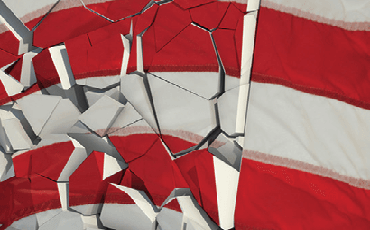Dawkins' Impossible Mountain
Dawkins' Impossible Mountain
In Richard Dawkins' best-selling book, The God Delusion, he sets out to prove why there is "almost certainly no God." However, in analyzing the first three chapters in last month's Truth and Consequences, we found a flurry of unsubstantiated claims, straw man arguments, non sequiturs, and question begging. Not a very good start for a book that claims to have vanquished God to the dustbin of ignorance and superstition.
But in Chapter 4 Dawkins enters his area of expertise, biology. And it is here that he makes his most vigorous argument for why God does not exist.
Climbing Mount Improbable
Dawkins begins by examining the question: How can we account for design found in nature? Even in Dawkins' estimation, everywhere we look we observe examples of complex arrangements of matter. Traditionally the only rational explanation for this design was an appeal to a Grand Designer. But Dawkins claims that the design we observe is only apparent, and offers an alternative answer, one of "stunning simplicity," "elegance," and "power." The scientific answer to the question of design, according to Dawkins, is natural selection.
In 1859, Charles Darwin's published his theory that in the daily struggle for life nature "selects" those organisms most fit to survive. The key to the explanatory force of natural selection is its focus on the small, incremental steps which over time lead to large-scale changes. Dawkins calls this process the "power of accumulation."
Dawkins illustrates the power of accumulation by using the analogy of climbing a mountain he dubs Mount Improbable. He explains that complex features, like eyes and wings, seem extremely improbable if we think in terms of getting there by one giant leap. However, what seems improbable becomes feasible if it is broken down into small, intermediate steps. It's like climbing a mountain, one small step at a time will eventually get you to the top.
Dawkins offers several examples of how complex features could have developed through natural selection's incremental process. Take the eye, for example. Dawkins writes, "
it is easy to imagine situations in which half an eye would save the life of an animal where 49 per cent of an eye would not
. [P]lausible intermediates are not only easy to imagine; they are abundant all around the animal kingdom."[1] He then suggests the eye of the flatworm and Nautilus are intermediate steps in the eventual evolution of the human eye. Dawkins concludes that "these invertebrate eyes, and many others, are all better than no eye at all, and all lie on a continuous and shallow slope up Mount Improbable, with our eyes near a peak
."[2]
According to Dawkins, natural selection accounts for the apparent design of eyes and wings and other improbable things. There is no need to appeal to a Designer or chance to accomplish what nature can do.
Is climbing Mount Improbable probable?
Dawkins assumes that getting from a light-sensitive spot to a human eye is simple, provided small steps are taken along the way. The problem with this scenario is that natural selection is not, as Dawkins asserts, "stunningly" simple. Natural selection turns out to be, in fact, merely a too-simplistic explanation. That's because it fails to account for the level of detail that science has uncovered during the past 20 years of research in genetics, cell biology, and biochemistry.
Biochemistry professor Michael Behe provides insight into the fine points that are missing from Dawkins' account of the evolution of the eye. In his book, Darwin's Black Box, Behe provides what a biochemically informed theory has to explain when it comes to human sight:
When light first strikes the retina a photon interacts with a molecule called 11-cis retinal, which rearranges within picoseconds to trans-retinal. (A picosecond is about the time it takes light to travel the breadth of a single human hair.) The change in the shape of the retinal molecule forces a change in the shape of the protein, rhodopsin, to which the retinal is tightly bound. The protein's metamorphosis alters its behavior. Now called metarhodopsin II, the protein sticks to another protein, called transducin. Before bumping into metarhodopsin II, transducin had tightly bound a small molecule called GDP. But when transducin interacts with metarhodopsin II, the GDP falls off, and a molecule called GTP binds to transducin. (GTP is closely related to, but critically different from, GDP.)[3]
Whew! And this is just the initial steps of the process! Behe continues for four long paragraphs providing an overview of the biochemistry of vision. The details and interconnections among various proteins, nerves, and brain cells are mind boggling. Yet, Dawkins' explanation focuses only on the gross anatomy of the organ while glossing over the actual nuts and bolts of sight. Yet it is on this level, the level of biochemistry, that evolution would have to make the necessary changes because this is the level at which all the actual work takes place.
To put this into perspective, Dawkins begins his illustration of sight with a light-sensitive spot, but he fails to account for how an organism can move from a spot that is not light-sensitive to one that is. What are the incremental steps involving the molecular transformation leading to sensitivity to light where before there was none? Without this process occurring naturally, Dawkins' story is an exercise in futility!
Not only does Dawkins fail to account for the details of how interconnected biochemical systems could evolve by small incremental steps, he neglects to mention that any small changes that might accumulate could also be reversed. This means that climbing Mount Improbable is a two-way street! What goes up can also come back down.
For example, the finches of the Galápagos Islands, known as Darwin's finches, are related species displaying varying sizes of beaks. Since Darwin's day, these have been touted as Exhibit #1 for illustrating natural selection in action. Yet, beginning in the early 1970's, extensive research found that the size of beaks varied according to the climate. During droughts, the average size increased due to birds with larger beaks being able to crack and eat larger, harder seeds. But when the rains returned, the average beak size went in the opposite direction. This means that the beaks varied slightly around a median range. In other words, it was not a steady trudge up Mount Improbable, but one step forward and one step back![4]
But even more importantly, no Finch beaks were observed developing into anything different; say an appendage like an elephant's trunk. And neither does Dawkins provide any real-life examples that offer gradual assent toward a new kind of structure, organ, or biochemical process. He can only point to micro-changes that account for minor adaptation of existing organs, or examples of species losing structures,[5] but never a "process of accumulation" toward greater complexity or novelty.
Take another classic example used by evolutionists, the lowly fruit fly. Fruit flies have been subjected to radiation to mutate the genetic material in an effort to produce a greater variety of offspring. The results: fruit flies with no wings, extra wings, shriveled bodies, or legs coming out of their heads, but no new organs or emerging structures. For the most part, the results were dead fruit flies. These experiments confirm that mutations can rearrange structures that are already there, but not add new features.
This means that, contrary to Dawkins' stories, experimental science demonstrates the stability of the species, not the step-wise evolution toward greater complexity or novelty. Getting to the top of Mount Improbable becomes a slippery slope indeed. As it turns out, Dawkins' stories of "a smooth gradient of advantage" up Mount Improbable is more science fiction than scientific observation. On closer inspection, Dawkins' mountain turns out to be a mirage.
Why God almost certainly does exist
On the other hand, when we move from imaginative stories to actual observations we find that design is far deeper and more sophisticated than we ever imagined. The more we discover about the inner workings of the cell and uncover the natural limits of change, the more we are faced with the inability of random mutations and natural selection to account for the web of interactivity that make up this wonderful thing we call life.
And the more knowledge we gain, greater is the conviction that what we are witnessing is, in fact, the result of intentional design-design that could only come from a source outside of the trifling abilities of material nature to produce-a design so intricate and compelling that the only reasonable conclusion is that it comes from the mind and hand of a Grand Designer.
Chuck Edwards
See related topics in the T&C archives (http://www.summit.org/resource/tc/):
- June, 2004: How an artificial "war" between science and religion was created as a way for secularism to triumph over Christianity.
- December, 2004: How to respond in biology class when evolution is addressed and a Creator is put down.
- February, 2005: Noted philosopher Anthony Flew moves from atheism to theism based on the argument from intelligent design.
- June, 2005: The origin of the eye as an example of "irreducible complexity," a key principle of intelligent design theory.
- August, 2005: Debunking the flat earth myth.
- January, 2006: Defending why "intelligent design" should be admitted in public school science classes, with an extended expose' of why naturalistic evolution is first and foremost a religiously held belief, not a scientific one.
- November, 2006: "Of Monkeys and Men" takes a closer look into the hypothetical evolutionary link between the great apes and homo sapiens.
Notes
- The God Delusion, Richard Dawkins, p. 124.
- Ibid., p. 124.
- Michael Behe, Darwin's Black Box (The Free Press, New York, 1996), p. 18-20.
- For the details of why Darwin's Finches do not support macroevolution, see Jonathan Wells, Icons of Evolution, Chapter 2.
- While Dawkins does not mention it in this book, the "evolution" of the whale appeals to a number of fossils that are assumed ancestral to modern whales. However, the process, if true, involves losing the function and eventually the structure of the hind legs. This may illustrate adaptation, but not appearance of greater complexity of novelty which is required if Dawkins' assent up Mount Improbable is correct. In addition, this example does not explain the arrival of legs to begin with, which is the issue at hand.
Support Our Broadcast Network
Trending Stories
Latest
We're a 100% Listener Supported Network
3 Simple Ways to Support WVW Foundation
Make Monthly Donations
-or-
A One-Time Donation
-
Mail In Your Donation
Worldview Weekend Foundation
PO BOX 1690
Collierville, TN, 38027 USA -
Donate by Phone
901-825-0652

















